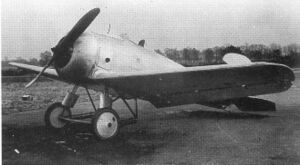Engineering:Handley Page Type S
The Handley Page Type S, or HPS-1 was a prototype British carrier-based fighter developed for the United States Navy in the early 1920s. A low-wing monoplane, it was unsuccessful, only two being built and flown.
Development and design
In 1921 the United States Navy drew up a specification for a single-seat fighter aircraft capable of operating either as a landplane from its aircraft carriers or from the water as a seaplane, seeking designs from both American and European companies. The British aircraft manufacturer Handley Page, which had recently developed the leading edge slot, realised use of slots and flaps could allow a high-speed monoplane to fly at the low speeds needed for carrier operations with a much higher wing loading than a normal biplane, and decided to develop an aircraft to meet this requirement. The resulting design, given the Handley Page designation Type S (and later retrospectively known as the H.P.21) was a small, low-wing cantilever monoplane, with full-span leading edge slots and full-span slotted flaps. The airframe was a plywood monocoque, with the fuselage capable of being broken into two sections for storage on board ship. It had a tailwheel undercarriage that could be replaced by two floats. Although designed to use engines of up to 400 hp (298 kW), the prototypes were fitted with a much less powerful surplus Bentley BR2 rotary engine.[1][2]
The US Navy placed an order for three prototypes, designated HPS-1 (Handley Page Scout) in the contemporary US Navy designation system.[3] The first prototype flew on 7 September 1923, but proved to have poor handling, with the rudder proving to be ineffective.[4] The second prototype was built with its wings fitted with six degrees of dihedral, flying in February 1924. It had much improved handling, and showed good speed at low level.[5] However, when undergoing full load trials for the US Navy at Martlesham Heath, it was wrecked when its undercarriage collapsed on landing, and the US Navy cancelled the contract, with the third prototype, intended to be a floatplane, not completed.[6]
Operators
 United States
United States
- United States Navy
Specifications (Type S)
Data from Handley Page Aircraft since 1907 [6]
General characteristics
- Crew: 1
- Length: 21 ft 5.5 in (6.541 m)
- Wingspan: 29 ft 3 in (8.92 m)
- Height: 9 ft 7 in (2.92 m) [7]
- Wing area: 114.5 sq ft (10.64 m2)
- Empty weight: 1,320 lb (599 kg)
- Max takeoff weight: 2,030 lb (921 kg)
- Powerplant: 1 × Bentley BR2 9-cylinder air-cooled rotary piston engine, 230 hp (170 kW)
- Propellers: 2-bladed fixed-pitch propeller
Performance
- Maximum speed: 146.5 mph (235.8 km/h, 127.3 kn)
- Stall speed: 44 mph (71 km/h, 38 kn)
- Endurance: 3 hours[8]
- Service ceiling: 21,000 ft (6,400 m)
- Rate of climb: 1,800 ft/min (9.1 m/s) [8]
Armament
- Guns: Provision for 2× .30 in (7.62 mm) Marlin machine guns
See also
Aircraft of comparable role, configuration and era
Notes
- ↑ Barnes 1976, pp.230-232.
- ↑ Mason 1992, p.170.
- ↑ Swanborough and Bowers 1976, p.485.
- ↑ Barnes 1976, p.232.
- ↑ Barnes 1976, p.237.
- ↑ Jump up to: 6.0 6.1 Barnes 1976, p.238.
- ↑ Green and Swanborough 1994, p.275.
- ↑ Jump up to: 8.0 8.1 Mason 1992, p.171.
References
- Barnes, C. H. (1976). Handley Page Aircraft since 1907. London: Putnam. ISBN 0-370-00030-7.
- Green, William; Swanborough, Gordon (1994). The Complete Book of Fighters. New York: Smithmark. ISBN 0-8317-3939-8.
- Mason, Francis K. (1992). The British Fighter since 1912. Annapolis, Maryland: Naval Institute Press. ISBN 1-55750-082-7.
- Swanborough, Gordon; Bowers, Peter M. (1976). United States Navy Aircraft since 1911 (Second ed.). London: Putnam. ISBN 0-370-10054-9.
 |


